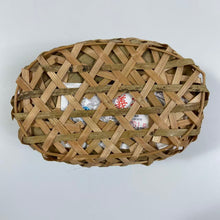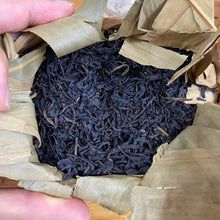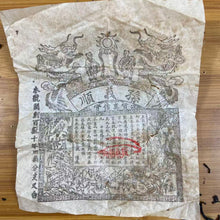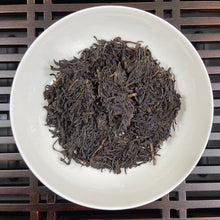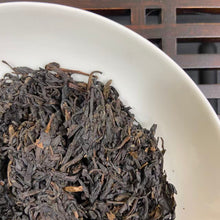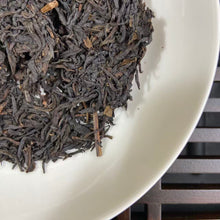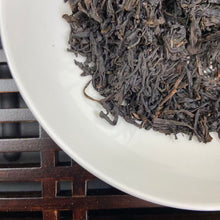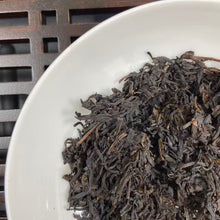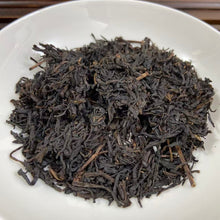
Video: Unwrapping and breaking down
Hand-picked spring material, crafted through a unique process spanning three seasons. Produced only once a year, each batch is a non-heritage, personally overseen, limited-edition treasure.
Core Origin: LuXi Township, Qimen County
- Spring: Fresh leaves hand-harvested and initial processing into maocha.
- Summer: Natural transformation through controlled storage.
- Autumn: Refined under night dew, absorbing the essence of sun and moon; every step infused with masterful intent.
Selection & Craft Exacting standards; traditional handwork honed by time. A subtle, lingering fragrance emerges from years of patient aging.
- Bamboo-leaf aroma surges into the nostrils.
- Dry tea: Full, penetrating scent; moist yet crisp.
- Appearance: Stout, tightly rolled cords; glossy, jet-black; bold with visible pekoe. After years of maturation, the leaves compact further, yielding a rich, mellow substance and enveloping aged fragrance.
Liquor Bright golden-yellow, thick and velvety; silky, satin-smooth, with a lingering resonance on the palate. Bamboo-leaf fragrance weaves throughout.
- Aroma: Steady, melodious aged notes.
- Taste: Full-bodied, sweet, supple; layered complexity; enduring, comfortable throat rhyme—refreshing and clean.
Infused Leaves Glossy, brimming with substance, exceptionally durable. Honeyed sweetness surges; vitality persists.
- Flexible cords, lustrous and abundant; base flavor robust.
- Lively and resilient; no pile-fermentation, no “heap taste.” Mature, mellow fragrance—rich and profound. Tail waters remain excellent. Suitable for daily drinking: never drying, soothing, and surface-releasing. After infusion, leaves may be stewed or boiled to fully unlock the superiority of aged tea.
Storage & Packaging Naturally stored and nurtured; wrapped in natural bamboo leaves, hand-woven into bamboo baskets.
Bamboo vessel + bamboo leaves + An Cha = three fragrances in harmony. Post-carbon roasting, the aromas meld; with further aging, the flavor grows ever more refined. This singular craft yields a singular fragrance—perfect for savoring now or cellaring for the future.
"An Cha" or "An Tea" is a Dark tea variety produced from Camellia sinensis var.sinensis cv.Zhuye, cultivated in the mountainous Qimen (Keemun) region. The harvest season typically ranges from late April to mid-May. Ancha is classified into several grades based on leaf quality:
- Te Gong (特贡 / Special Tribute): Comprising 1 bud and 2 leaves, this grade features tight and neat threads, offering a mellow, sweet taste with good Huigan.
- Gong Jian (贡尖 / Tribute Bud): Mainly 1 bud and 2 leaves, with a few tiny stems. The tea threads are tight and neat, with a mellow, sweet taste and noticeable Huigan.
- Te Ji (特级 / Special Grade): Mostly 1 bud and 2 leaves, mixed with a certain ratio of tiny stems, resulting in a relatively tight and neat thread and a mellow, thick, and sweet flavor.
- Yi Ji (一级 / 1st Grade): Consists of 1 bud and 2-3 leaves mixed with larger leaves and stems, characterized by a mellow, thick, and smooth taste.
- Er Ji (二级 / 2nd Grade): Involves 1 bud and 2-3 leaves mixed with rough leaves and stems, offering a mellow, thick, and smooth flavor.
Historical Context: Ancha dates back to around 1725 AD (Emperor Yongzheng, Qing Dynasty) and was temporarily discontinued in 1937 due to WW2. It was revived in the late 1980s following inquiries from Hong Kong customers. The original technology and recipe were lost, but local elders with partial memories contributed to its revival. Ancha was successfully recovered in 1991, thanks to the efforts led by Mr. Wang Zhenxiang.
Production Process: Ancha's production involves junior and senior processes. The junior process, typically completed by tea farmers, includes Sun drying, Killing green, Rolling, and Drying. The senior process involves 9 steps: Selection, Blending, High Fire Drying, Night Dew, Steaming, Bamboo Packaging, Fire Drying, and Packaging.
As a semi-fermented tea, Ancha continues to age (natural fermentation) over time. Similar to Puerh tea, it improves with age, and its taste and flavor evolve annually under dry, clean, and cool conditions. Proper storage is crucial to prevent odor transfer.













